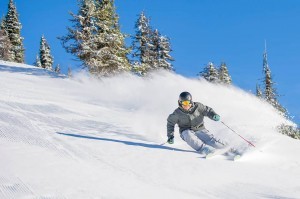Slow it down to get better
Last week I had a ski lesson. And it was one of the times when I had an 'aha' moment. During the lesson the instructor, Sander, had me try doing big and small radius carving turns.
[caption id="attachment_4577" align="aligncenter" width="300"] Sander showing how it's done.
And I noticed something that surprised me. I felt smoother and skied better with small, quick turns than I did with larger turns. This was surprising because I would have thought that adding speed to a movement makes it more technical and thus more difficult.
In the case of the turns when I performed small, quick turns there was a natural stretch reflex that flowed from one turn to the next. The momentum initiated the weight transfer, the rolling of the skis, the tall and short stature as well the angulation and inclination necessary to carve the skis. (had to throw in the part about inclination for Greg)
If you're not a skier, don't worry. The take home message is that skiing with speed and quicker turns creates a momentum and a flow which makes it easier, for me anyway, to get on the edges of my skis.
When I went to larger turns I was staying forward in my boot through the turn. This wasn't allowing the ankle to release and thus was blocking the chain reaction of events that should follow from the release of the ankle i.e. getting taller, realigning the knees, shifting the hips, achieving good angulation and inclination.
It's kind of like trying to steer your car with the brakes on (I'm not a car guy, so cut me some slack here). When the brake is pressed through the floor you don't have the same freedom to control the car by steering it. Only once you release the brake can you regain more control of the vehicle.
Well by staying forward in my boot it was as though I was keeping the brake on continually making it harder to roll the skis, get on edge, achieve a full weight transfer and go from shorter through the turns to taller during the traverse of the hill.
It was only by playing around with smaller quicker versus larger, slower turns that I could appreciate this.
So what does this mean with your training? Well with some of your bodyweight movements, particularly the ones done quickly, try doing them slowly. And in control.
For example, try doing a lateral bound drill and hold the landings for 5 seconds. The goal is to stick each landing with no windmill arms, no pivoting at the foot or any body motion at all.
[caption id="attachment_4578" align="aligncenter" width="300"] Stick and hold the landing for 5 seconds.
Stick and hold the landing for 5 seconds.
Think of basketball in a room with motion detectors. If you move the foot you land on you'll travel. And if you land with any kind of sway or body motion you'll set off the motion detectors.
Try the drill again with speed and you'll find it's much easier.
With all the emphasis on speed, power and performance in training sometimes control and precision can be masked. Practice different bodyweight drills typically done explosively with speed and find out where you struggle when you slow these down. Look for a drill that improves your movement at slow speed (hint: talk to an Okanagan Peak Performance Inc coach for help here). Then gradually work back to performing the drill explosively and realize the improved control and mastery of the movement.
Chris [fb-like]
When you subscribe to the blog, we will send you an e-mail when there are new updates on the site so you wouldn't miss them.

Comments